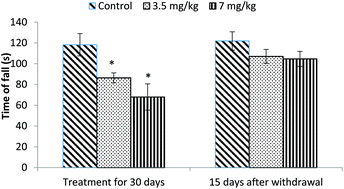当前位置:
X-MOL 学术
›
Toxicol. Res.
›
论文详情
Our official English website, www.x-mol.net, welcomes your
feedback! (Note: you will need to create a separate account there.)
Bifenthrin-induced neurotoxicity in rats: involvement of oxidative stress
Toxicology Research ( IF 2.2 ) Pub Date : 2017-10-12 00:00:00 , DOI: 10.1039/c7tx00205j Farah Syed 1, 2, 3, 4, 5 , Kumud K. Awasthi 1, 2, 3, 4, 5 , Lalit P. Chandravanshi 2, 5, 6, 7, 8 , Rajbala Verma 1, 2, 3, 4, 5 , Neelu K. Rajawat 1, 2, 3, 4, 5 , Vinay K. Khanna 5, 6, 7 , P. J. John 1, 2, 3, 4, 5 , Inderpal Soni 1, 2, 3, 4, 5
Toxicology Research ( IF 2.2 ) Pub Date : 2017-10-12 00:00:00 , DOI: 10.1039/c7tx00205j Farah Syed 1, 2, 3, 4, 5 , Kumud K. Awasthi 1, 2, 3, 4, 5 , Lalit P. Chandravanshi 2, 5, 6, 7, 8 , Rajbala Verma 1, 2, 3, 4, 5 , Neelu K. Rajawat 1, 2, 3, 4, 5 , Vinay K. Khanna 5, 6, 7 , P. J. John 1, 2, 3, 4, 5 , Inderpal Soni 1, 2, 3, 4, 5
Affiliation

|
Extensive use of synthetic pyrethroids has resulted in serious human health issues. Induction of oxidative stress is an important mechanism of action of most pesticides including pyrethroids. In the present study, we have elucidated the possible role of oxidative stress in bifenthrin-induced neurotoxicity. Adult male Wistar rats were administered bifenthrin (3.5 and 7 mg per kg body weight p.o.) for 30 days. Behavioral studies were conducted on a set of randomly selected rats from each treatment group after completion of treatment. Neurochemical parameters were assessed 24 h after the last dose was administered. The selected behavioral and neurochemical endpoints were also assessed 15 days after cessation of exposure to reveal whether the neurobehavioral changes produced by bifenthrin were temporary or permanent. Deficits in motor activity, motor incoordination, and cognitive impairment were observed after exposure to bifenthrin. Levels of biogenic amines viz. dopamine (DA) and its metabolites, i.e. 3,4-dihydroxyphenylacetic acid (DOPAC) and homovanillic acid (HVA), epinephrine (EPN), norepinephrine (NE), and serotonin (5-HT) altered in the frontal cortex, corpus striatum, and hippocampus of bifenthrin-treated rats. A decrease in the activity of acetylcholinesterase (AChE) occurred in all regions of the brain. Both doses of bifenthrin significantly induced lipid peroxidation (LPO) and increased protein carbonyl levels in the frontal cortex, corpus striatum, and hippocampus of rats. The activities of antioxidant enzymes, i.e. catalase, superoxide dismutase, and glutathione peroxidase, were also suppressed in all selected regions of the brain. A trend of recovery was, however, observed in all the behavioral and neurochemical endpoints 15 days after withdrawal of exposure. Oxidative stress seems to play an important role in bifenthrin-induced neurotoxicity. Our study suggests that long-term exposure to these compounds can produce detrimental effects.
中文翻译:

联苯菊酯诱导的大鼠神经毒性:氧化应激的参与
大量使用合成拟除虫菊酯导致严重的人类健康问题。氧化应激的诱导是大多数农药(包括拟除虫菊酯)的重要作用机理。在本研究中,我们已经阐明了氧化应激在联苯菊酯诱导的神经毒性中的可能作用。成年雄性Wistar大鼠被给予联苯菊酯(每公斤体重口服3.5和7mg)30天。在完成治疗后,对来自每个治疗组的一组随机选择的大鼠进行了行为研究。最后一次给药后24小时评估神经化学参数。停止接触后15天还评估了选定的行为和神经化学终点,以揭示联苯菊酯产生的神经行为改变是暂时的还是永久的。运动不足,接触联苯菊酯后观察到运动不协调和认知障碍。生物胺水平即。多巴胺(DA)及其代谢物,即额叶皮层,纹状体中的3,4-二羟基苯基乙酸(DOPAC)和高香草酸(HVA),肾上腺素(EPN),去甲肾上腺素(NE)和5-羟色胺(5-HT)发生了变化和联苯菊酯处理的大鼠的海马区。乙酰胆碱酯酶(AChE)的活性降低发生在大脑的所有区域。两种剂量的联苯菊酯均显着诱导大鼠额叶皮层,纹状体和海马中的脂质过氧化(LPO)和蛋白质羰基水平升高。抗氧化酶的活性,即过氧化氢酶,超氧化物歧化酶和谷胱甘肽过氧化物酶在大脑的所有选定区域也被抑制。但是,在撤除暴露15天后,在所有行为和神经化学终点均观察到恢复趋势。氧化应激似乎在联苯菊酯诱导的神经毒性中起重要作用。我们的研究表明,长期暴露于这些化合物会产生不利影响。
更新日期:2017-11-02
中文翻译:

联苯菊酯诱导的大鼠神经毒性:氧化应激的参与
大量使用合成拟除虫菊酯导致严重的人类健康问题。氧化应激的诱导是大多数农药(包括拟除虫菊酯)的重要作用机理。在本研究中,我们已经阐明了氧化应激在联苯菊酯诱导的神经毒性中的可能作用。成年雄性Wistar大鼠被给予联苯菊酯(每公斤体重口服3.5和7mg)30天。在完成治疗后,对来自每个治疗组的一组随机选择的大鼠进行了行为研究。最后一次给药后24小时评估神经化学参数。停止接触后15天还评估了选定的行为和神经化学终点,以揭示联苯菊酯产生的神经行为改变是暂时的还是永久的。运动不足,接触联苯菊酯后观察到运动不协调和认知障碍。生物胺水平即。多巴胺(DA)及其代谢物,即额叶皮层,纹状体中的3,4-二羟基苯基乙酸(DOPAC)和高香草酸(HVA),肾上腺素(EPN),去甲肾上腺素(NE)和5-羟色胺(5-HT)发生了变化和联苯菊酯处理的大鼠的海马区。乙酰胆碱酯酶(AChE)的活性降低发生在大脑的所有区域。两种剂量的联苯菊酯均显着诱导大鼠额叶皮层,纹状体和海马中的脂质过氧化(LPO)和蛋白质羰基水平升高。抗氧化酶的活性,即过氧化氢酶,超氧化物歧化酶和谷胱甘肽过氧化物酶在大脑的所有选定区域也被抑制。但是,在撤除暴露15天后,在所有行为和神经化学终点均观察到恢复趋势。氧化应激似乎在联苯菊酯诱导的神经毒性中起重要作用。我们的研究表明,长期暴露于这些化合物会产生不利影响。










































 京公网安备 11010802027423号
京公网安备 11010802027423号